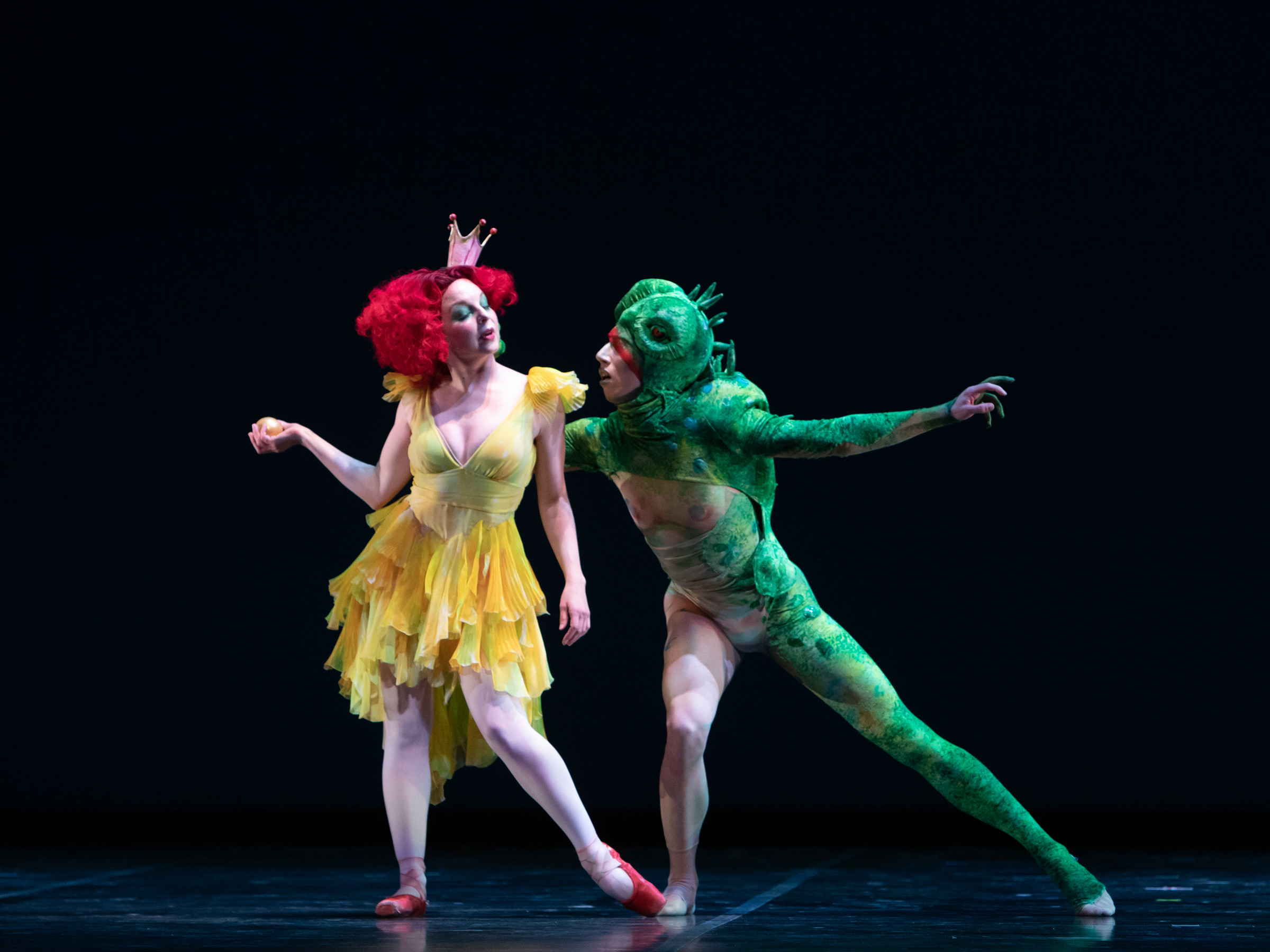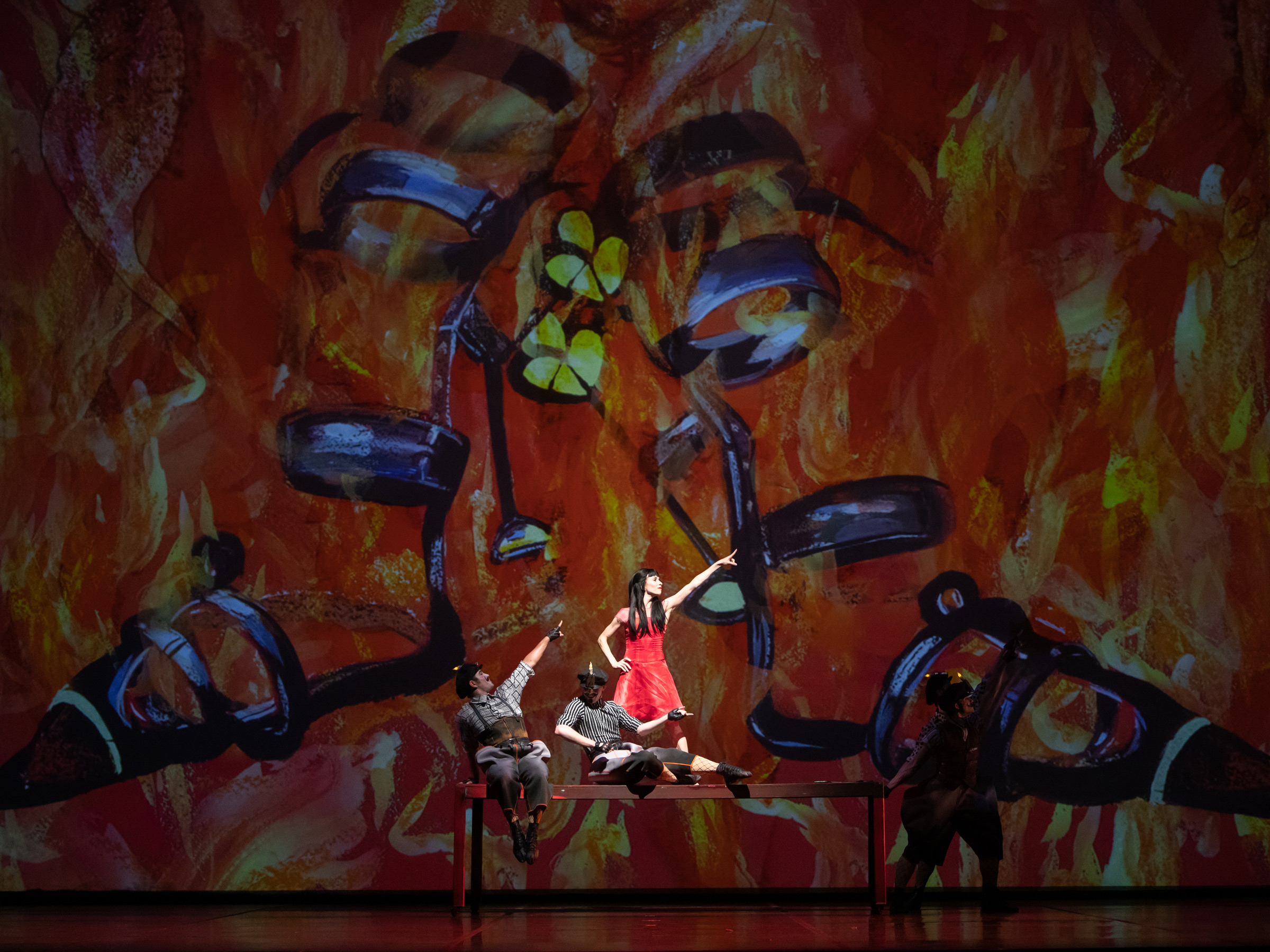Grimm Tales at Ballet Austin
Visual art and dance forming a feverish nightmare

Grimm Tales at Ballet Austin is a hyper-stimulating visual experience wherein Natalie Frank‘s compelling drawings and Stephen Mills‘ contemporary choreography demand equal attention. Seen through Frank’s women protagonist-focused perspectives, these fairytale adaptations draw into light the gruesome warnings the original Brothers Grimm stories tell. Two years in the making, the production began when the curator of Austin’s Blanton Museum of Art, Veronica Roberts, introduced Mills to Frank’s drawings. The choreographer went to NYC to see the colorful works while they were exhibited at The Drawing Center. Later, when they were shown at the Blanton Museum, he brought his entire dance company for inspiration.

Mills not only wanted Frank’s art in his expansive collection, but also desired the works to come to life. In a post-performance discussion, he explains, “We were interested in telling the dark and sinister original stories, not the Disney versions.” This rejection of the Disney interpretations—that have overwhelmed mass culture—lends an integrity to the production and offers a look into unmediated human desire.
We were interested in telling the dark and sinister original stories
Working with set designer George Tsypin, Frank produced around 30 drawings that would be animated by Scott Warner to correspond with the musical score composed by Graham Reynolds. In an interview with Ballet Austin, Frank remarks on her challenges. “The idea of approaching these drawings is radically different from how I approach my work,” she says. “I’m so used to centering the drawings around the figure and with these projections the figure is the dancer. So the figure is already there and you don’t want to steal the dancer’s thunder or distract from the beautiful movement of the dancer.”

This use of negative space in her interior landscapes required a corporeal activation. Scene and movement were coordinated meticulously. And, along the way, other elements of set design and costuming gained a painted-over look as Frank’s 2D drawings were translated into 3D forms. While it would be easy for all these interwoven aspects to battle with one another, the successful execution allows for a seamless narrative flow that works symbiotically.
The ballet highlights three tales from the Brothers Grimm book. Mills explains that the creative team chose stories based on hunger, “With the frog king being a sexual hunger, Snow White being a hunger for beauty, and then the final story, The Juniper Tree, being a hunger for power and control.” The revisitation of these fairytales at their origin source, from a translation by Jack Zipes, allowed for contemporary modes of ballet to arise.

In The Frog King, we see the contorted movements of the main character danced by Oliver Greene-Cramer as his anthropomorphized body bends and twists around the body of The Princess, danced by Jamie Lynn Witts. In classical ballet, the role of the woman dancer is subject to her male partner; bent and spun around oftentimes with little agency. This story revolves around the fulfillment of a promise made by the Princess to the Frog King. When she changes her mind, the forceful hand of her father, The King, demands that she sees it through.
There is a reversal of gendered roles of the dancers, exploring the themes of consent and its withdrawal—ultimately explored in a climactic scene where The Princess rejects the advancements of the Frog King and throws him against the wall—splattering him dead to reveal her noble prince.

The ballet continues with Snow White, though with focus drawn on the violent battle between two women in the name of beauty. It’s uninterrupted by the “life-giving kiss” of the prince, and emphasizes collective mutual support, love and care provided by the seven dwarfs. As the poisonous exchanges between the queen (danced by Aara Krumpe) and Snow White (danced by Ashley Lynn Sherman) continue throughout the performance, the dwarfs work tirelessly to revive her. The queen’s hunger is symbolized by the poison apple that finally allows her to reclaim her title, the “fairest of them all.”

As Snow White succumbs to the poison, the dwarfs gather to physically support her—transferring weight equally back and forth from one to another as her languid body moves. As Snow White is brought back to a state of lively beauty, the queen is forced to wear red-hot iron shoes that make her dance until death. Her movements are frantic as she is thrown and held in the air and turned upside down by the dwarfs.

The final and most daunting of these stories, The Juniper Tree, begins with a scene of romance as a young couple dreams of having a child. The wife sits beneath the aforementioned juniper tree wishing for a child as she peels apples. She cuts her finger and a drop of her blood soaks into the snow at its base. As the seasons change from winter to spring, the tree gives her a baby boy. Overjoyed, she relishes in the happiness of her family but dies of an overfilled heart. She’s buried underneath the tree. The father remarries— and then enters the stepmother (danced by Elise Pekarek) and daughter, (danced by Chelsea Marie Renner).

The stepmother’s hunger for power and control is communicated through her attempts to secure her daughter’s the full inheritance. At the dramatic and gruesome apex, the stepmother decapitates the young boy as he attempts to get an apple from her chest. The trembling movement from the daughter that ensues makes her anxiety palpable, as she assists her mother in dismembering the boy and making him into a stew for his father to eat. The daughter, with lamenting movements, collects the remaining pile of bones in a silk scarf and returns them to the tree.

The boy is reincarnated into the body of a yellow singing bird and reenters the stage. His reemergence ends the trembling movements by the daughter as they dance in tandem, displaying their equal stance. The bird ends the scene as he crushes his stepmother with a millstone and returns into his boy body—reunited with his father and sister.
This premiere production offers an exciting look into the world of contemporary ballet choreography and its ability to address popular culture. The numerous vantage points of hunger persisting throughout the performance point out the dilution (or perhaps sweetening) of Disney’s interpretations. Here, the violent questioning of agency over one’s body, coupled with the gender expectations of dance, create a key distinction. Further, the performance creates an impact that cannot be found in the classical stories we have grown accustomed to in ballet—sparking an urgency to create contemporary work the public is craving to experience.
Images by Anne Marie Bloodgood, courtesy of Ballet Austin











